
NOTE: This story first appeared in 2009 on my old site. Content has been migrated here.
It was probably about 30 years ago, in 1979, when my folks dragged me along to a dinner they were having with some couple at that couple’s home. I was bored, being 9 and the only kid there, but the husband took me downstairs to a finished basement and showed me a row of white, longboxes. I’d never seen them before. He lifed the lid to the first one, and pulled out Peter Parker The Spectactular Spider Man #2. The one where Spidey is getting smacked by Kraven and some wicked-cool dude with a do-rag and toe spikes is about to hit poor Webhead in the back.
I never met that guy again, but I owe him a huge thanks. That night, I left with PPTSS #s 1-5 and a few other books, all neatly sealed in plastic. I also left with a new hobby and my first lifetime passion.
I am not your typical comic book reader. I don’t much care about the long story arcs that are the rage today. For me, great comics always have and always should be things I can pick up and immediately become lost in, without needing too much back story. Spider Man should always have an Aunt May and he should always have girl problems. Superman should always have to keep his identity a secret from Lois. Dick Grayson becoming Nightwing was okay, but most other change I just don’t like. Comics should be timeless. I don’t care how many times it happens, it’s always great when Joker escapes Arkham or The Red Skull returns or Galactus breaks his word and comes back to Earth with a knife and fork. The repetition is part of what makes mythology. And the 1980s were all about good stories. It was before the D.C.U. remade itself, before The Avengers started renumbering their issue numbers, before the Young JLA, tons of cheap reprints, and all the attempts to turn delicious, five-star comic books into mass-produced, easily available potato chips. I remember paying a buck fifty (I think) for the first Teenage Mutant Ninja Turtles book, and then selling it in a few months for $140. I remember buying triples of Daredevil #181, Spider Man #252, and even ‘Mazing Man (I lost money on that one). In the 1980s, comics were collectible. They never really would be again.
So, I’m dedicating this article to the best comic book stories 0f the ’80s. The idea here is to find the best stories, not the best writer/artist runs (i.e., John Byrne’s Fantastic 4, Claremont and Cockrum’s X-Men, etc.) or the best long-running story arcs (i.e., the gradual development of Elektra the assassin, Dark Phoenix, etc.) or the most innovative ideas (like the sideways Fantastic Four or the wordless Spider Man, or even the genius of Assistant Editors Month). I’m looking for stories that were self-contained in a finite number of issues; stories that can be picked up and understood easily, by new readers and old ones alike. And I’m looking only at Marvel and D.C. (If you’re curious, if I had to pick great indie books of the era, I’d be looking at Dreadstar, Grendel, American Flagg!, and Cerebus.)
If I missed something, tell me. If I got it wrong, you can tell me that, too.
Lastly, I note that this list is biased towards Frank Miller because he’s Frank Miller.
Really lastly, this list will start at one. I ain’t no Kasey Kasem.

1. The Dark Knight Returns (1986)
Easily the most influential comic book of the modern age. No comic book has done more to push the genre forward, out of the primitive words-and-pictures realm and into something mythic and deeply psychological. Even if it just had the battle between the aged Superman and Batman, it would have been worth the price of admission. Arguably, Frank Miller could never have created this book without first going through his incredible stint on the Daredevil series, but I once read an interview in which he claimed that he thought of this storyline first. Although the book can sometimes focus too much on text, the tale it tells is pure genius and made possible the Tim Burton films, Batman: The Animated Series (the best Bat-toon ever), and even Batman Beyond. Not to mention the overall movement of comic writing into pseudo-realism. At the same time, it crushed the innocence of the art form, making books that were once perfect for kids into something that parents had to look at a little more closely. A sad side effect.

2. The Watchmen (1986-87). One of the earliest examples of comics-as-literature: There’s a story within the story that acts as a Greek chorus for the main idea, characters who spring fully formed with back-stories and well-drawn personalities, and a world view that was easily accessible as it borrowed from comic-book expectations (by providing Batman, Superman, Wonder Woman types) but also turned the standard superbooks upside down. Why is there a pirate comic within the main story? Are these guys really heroes, because some of them act like villains. What are their powers, even? Dave Gibbons’ art was deceptively simple, for a tale so bold. As it unfolded, month to month, it became the book we all looked forward to more than anything.
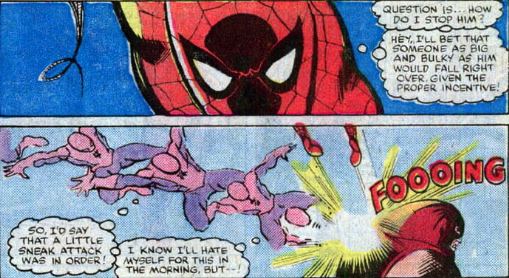

3. Amazing Spider Man #229-230 (1982). In 1982, Roger Stern, the man responsible for the some of the best Spider Man stories ever written, and John Romita, Jr., matched Juggernaut vs. the Webhead. Romita’s artwork is simple and straightforward, a stark contrast to the more popular, complex art of the time, but this style has always been the one that best suits Spidey. At bottom, he’s a simple character with very basic desires, and is easily the most human of all the Marvel heroes. There were many other great stories from this era, of course, including #238 (the first appearance of Hobgoblin, a more sadistic, more powerful Green Goblin), but those books were most parts of a great arc, not self-contained stories. #s 229 and 230 are essentially one long battle, with the Wall Crawler getting pummeled, punched, thrown, and crushed under a building before finally defeating his enemy . . . By mistake! Exciting, appropriate for all ages, and, sadly, never reprinted in a color volume. It is the greatest Spider Man story ever.
4. Daredevil #181 (1982). Everything leading up to this issue is brilliant, too, by the way, but this one, the death of Elektra, is the best of the bunch. I’d recommend you buy all the Miller/Janson collections. I’m sure I’ll get shit for putting this below Spidey. I’ll also get shit for putting it above the death of Jean Grey.\
5. The Uncanny X-Men: Days of Future Past (Bound volume) (1981). Chris Claremont created many great X-Men stories, including the Dark Phoenix saga, but at the same time Claremont, like Stan Lee, was always a little too verbose, leading to crammed panels in which word balloons fought with the pictures for space. Plus, time travel is never a promising beginning for a story. But John Byrne brought out the best of Claremont’s vision. Here, we get to see a dark future much like that in the Terminator movies, in which Wolverine—now an older guy—gets to be fully unleashed, and make out with Storm! The cover featured a photo array of the team, with members labeled “Missing,” “Deceased,” or “Apprehended.”
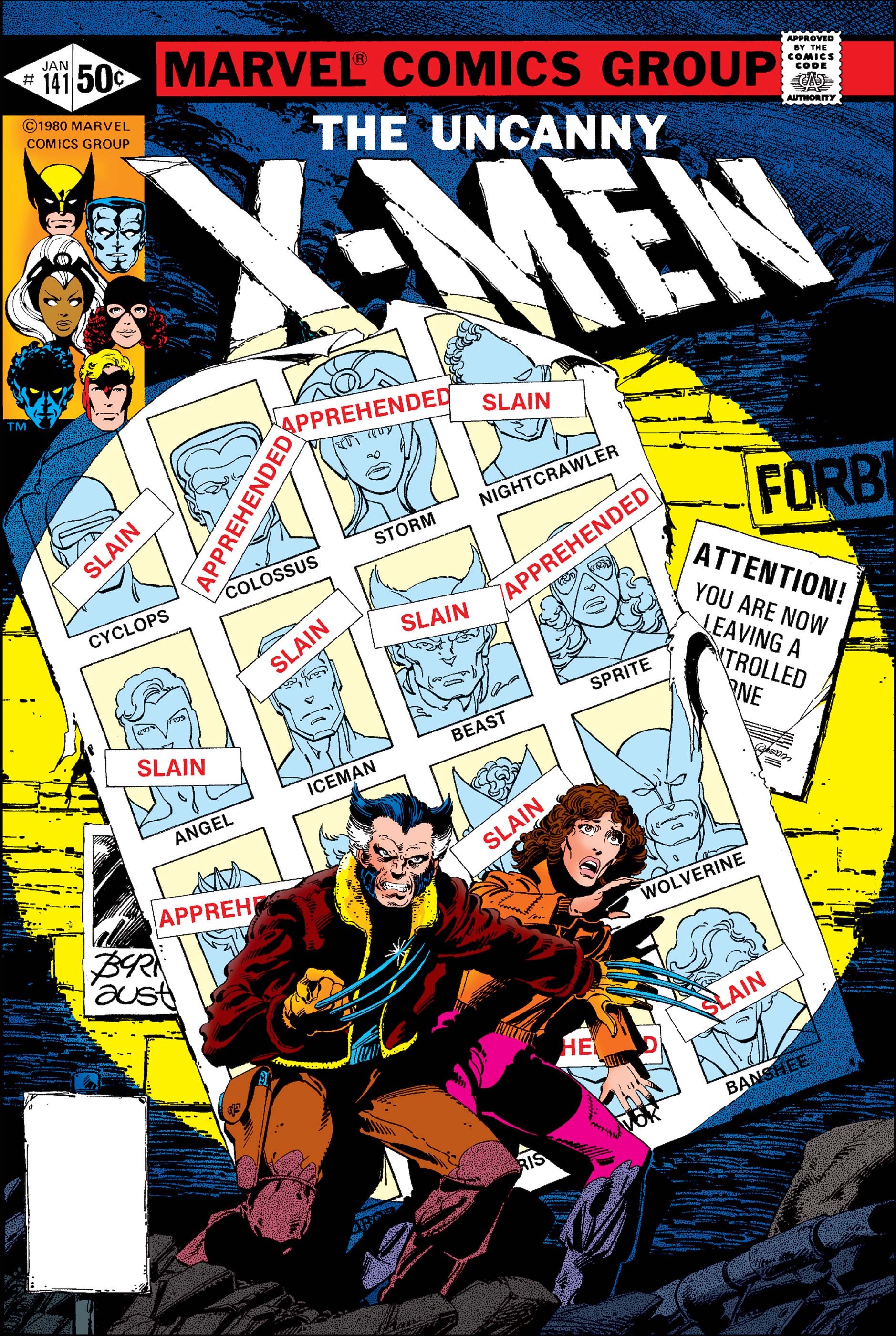
It also has one of the most page-turning covers in history, and this story became the basis for the Danger Room sequence in the third X-Men film. I’m sure most comic “experts” will fault me for having this here but not Dark Phoenix, but this story I can read over and over, never getting bored.

6. Avengers Annual #10 (1981). There are certainly better Avengers story arcs, but the problem with their monthly book is that it tended to drag stuff out, to focus too much on every individual character at the expense of cohesive, exciting stories. But in an annual, which is supposed to hold one completed story, the team finally came out its cage fighting. It’s the one where we first meet Rogue, and she gets her super powers, and Ms. Marvel loses hers. It’s the one where the Earth’s mightiest heroes get to fight the Earth’s most powerful super-villain gang—the Brotherhood of Evil Mutants. It’s Spider Woman’s first time alongside The Avengers, predating her joining the team 20 years later. Michael Golden’s somewhat murky art is perfect for this, the only noir Avengers comic ever made, and Armando Gil’s heavy inking completes the mood. This book exemplifies the interwoven nature of the Marvel universe—it introduced a character who would become a major player in the X-Men (much like Wolverine found his origin in the pages of The Hulk), and provided major story developments for both Spider Woman and Carol Danvers, neither of whom were (at least at that time) regulars in the Avengers series.

7. Kraven’s Last Hunt a.k.a. Fearful Symmetry (Hardcover) (1987). Extremely dark, both in tone and in the powerful artwork by Mike Zeck, here we actually get to read the death of Spider Man. It’s kind of like if Frank Miller got to write for Spidey. Perhaps the most innovative thing about it, though, was its focus on the villain. When villains die, we rarely give them an appropriate send off. Plus, I’m pretty sure that Kraven has actually stayed dead, hasn’t he? If I’m right, that’s a rarity unto itself!
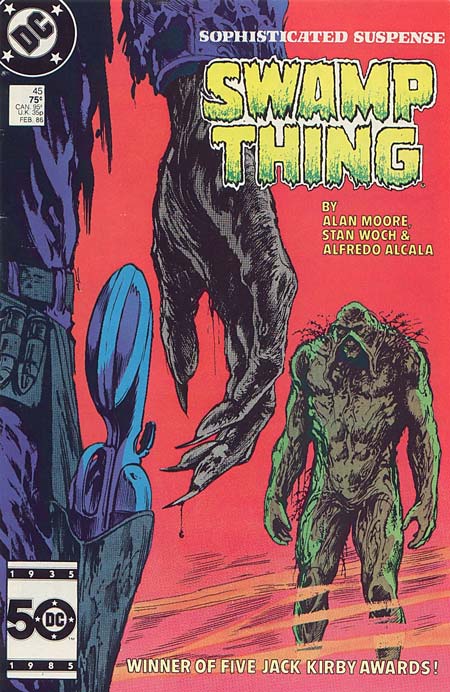
8. Swamp Thing #45 (1986). Titled, “Ghost Dance,” this story, for me, will always be called, “The Sound of the Hammers Must Never Stop.” Although this list is supposed to be dedicated to men in tights, and Swampy certainly doesn’t fit that bill, muck man he was featured in a mainstream D.C. book, and he’s fought Superman, The Demon, and a bunch of other dudes, so I’m including him. In his famous run on this series, Alan Moore, a super-genius of the highest order, managed to bring the horror back into comics without relying on gore or nudity to sell it. Here, he created an intelligent scary story about a wealthy woman so obsessed with building additional rooms on to her mansion that the construction continued long after her death. A metaphor, perhaps, for the comic-book industry, which at the time was showing signs of wear as characters continued to play out the same story (Kryptonite again? Spidey forgot to fill his web-shooters for the fifth time in a year?) in a genre that, in the late 1980s, was in desperate need of a reinvention that wouldn’t really arrive until after 2001.
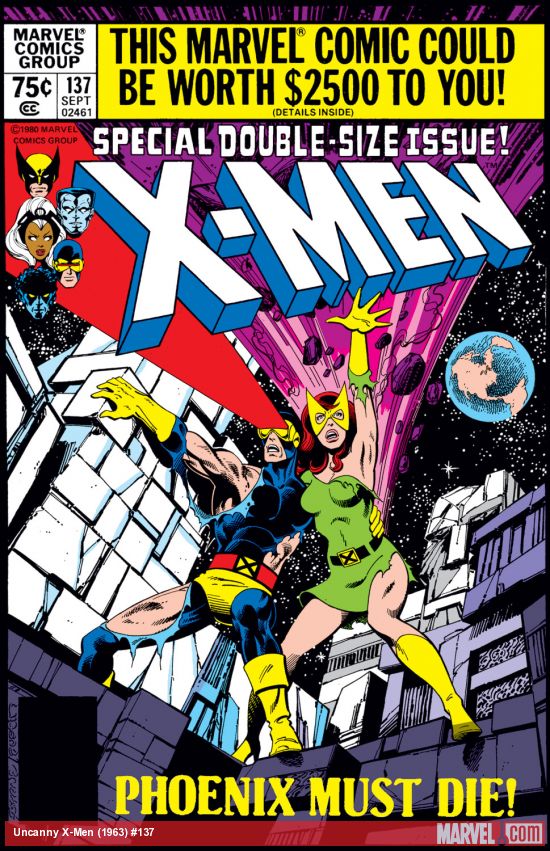
9. X-Men: The Dark Phoenix Saga (Bound volume) (1980). The power of this storyline has been diminished, in my view, by the number of times Jean Grey came back to life. But at the time, this was a gut-wrenching kick in the face of the fans who had been with this team since day one. No death has been more influential, no story more terrifying for fans who finally realized that nothing was safe

10. Batman: Year One (1987). Frank Miller teams up with David Mazzucchelli, with whom he did the great Daredevil: Born Again (where we got to see Captain America through Miller’s eyes!), to remake the origin of D.C.’s most interesting character. It formed the storyline for the Batman Begins film. Miller is truly an expert at recreating heroes in his own image, and he is the writer who gets Batman more than any other in history. All Star Batman continues this tradition today.

11. Daredevil #184-185 (1982). The two-part Daredevil vs. Punisher storyline, titled, “Child’s Play,” that introduced many young nerds to the world of PCP. Written by Frank Miller, these two books manage to accomplish what most novels never do: They advance the regular storyline of the DD series; provide readers with a match-up of Marvel’s two most streetwise characters, which many of us were waiting anxiously for; provide a sociopolitical view on drugs (and how they get into our schools); and provide a moral, cautionary tale. And the covers were brilliant, too. A blind man holding a revolver, a la Dirty Harry, with the bold words: “No More Mister Nice Guy.” If that didn’t move you to fork over the cash, DD getting shot by the Punisher, in the gut at close range, had to get your attention.

12. The New Teen Titans: The Judas Contract (Bound volume) (1984) Teen Titans was one of the most fun books to read back when, but the individual stories were rarely classic. The closest they came was when Blackfire came to Earth and kidnapped Starfire, but the story got regrettably sidetracked by the introduction of The Omega Men, in a pathetic attempt to launch a spin-off series. But this tale, which featured the rise and fall of the traitorous Terra, was fantastic. Readers never really knew whether Terra was a good-girl-gone-bad or a good-girl-gone-bad-gone-good-again, and that mystery kept the storyline taut and exciting. It also represented the first real test for Dick Grayson’s rebirth as Nightwing, and introduced Jericho as a major character. I understand they’re working on an animated film of it. Can’t wait.

13. Camelot 3000 (1982). I suppose it’s kind of cheating to put this 12-issue maxi-series on the list, much as it was cheating to use Watchmen, because this is supposed to be a list of self-contained stories and 12 issues is more of a spraw than a single tale, but I’m including it because it did what no comic before it could do: Utilize the Arthurian legend to positive effect. The JLA have fought Morgana La Fay, Merlin has appeared in dozens of funny books, Lancelot and Arthur, too, have been known to appear with the likes of Spiderman, Shining Knight, and The Demon, among many others, and it’s always, always stupid. The best use I’ve seen so far, other than Camelot 3000, was on a recent episode of Batman: Brave and the Bold, in which Batman and Green Arrow competed for Merlin’s affections. But that was still stupid. It was just funny-stupid.
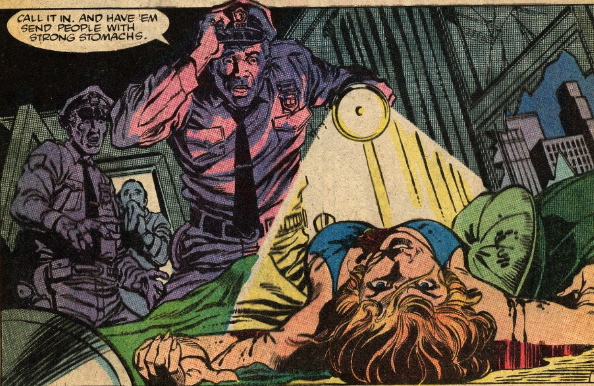
14. Peter Parker the Spectacular Spider-Man: The Death of Jean DeWolff (1985-86). Regular fans were shocked at the decision to kill off a major supporting character, especially at the hands of a shotgun-toting lunatic with no apparent powers or history in the Marvel Universe. Written by Peter David, another star of the industry, the story featured a darker Spider Man–in his black costume.

It goes hand-in-hand with Kraven’s First Hunt as one of the rare examples of an gritty Spidey in a fantastic story. Incidentally, it was Peter David’s first work in comics, and it led many fans to hate him.
15. The Uncanny X-Men #143 (Included in “Days of Future Passed” bound volume) (1981). A one-and-done Christmas sidebar in which Kitty Pryde gets to have her first solo adventure . . . without leaving the house! The Brood have always been my favorite aliens (other than T.V.’s cat-eating Alf, of course).
It’s a simple tale of girl-versus-monster, but the artwork is brilliant and the story is so well done that it can be read again and again. It was kind of like my personal “Night Before Christmas,” which I’d read every holiday to get warm, hot-chocolatey feelings.

16. Batman: The Killing Joke (1988). Yet another Batman entry. That kind of suprises me, because I’ve often been disappointed by the Batbooks. It’s also another Alan Moore, which doesn’t surprise me at all. He may hate D.C. forever, but he’ll always be the second-greatest writer to work for them. An interesting take on the origin of arguably the most compelling villain in comic history.

17. Fantastic Four #274 (1985). The FF have never been my favorite team. The concept is cool, but they never seem to get stories that work well. The exception was John Byrne’s fantastic run, which included the greatest Galactus story ever told, in which Reed shows mercy on the big, lovable planet-eater, and in which Johnny’s girlfried, Frankie Raye, does the Norrin Radd thing and becomes a cosmic waiter. This self-contained issue took place during the time that The Thing went off to have his own comic book (he failed as a solo act), and is definitely the sexiest FF story ever. She Hulk decides to sunbathe topless on top of the Baxter Building, and along come some paparazzi in a helicopter. Monkey business ensues. Maybe it was just hormones, but I read this over and over again. Oh, and get a load of Stan “Hef” Lee on the cover!

18. Whatever Happened to the Man of Tomorrow? (1986). Another Alan Moore effort, complimented by the underrated Chris Swan. Superman is a great character, and his stories from the 1950s and ‘60s are the best the Golden Age has to offer. But until the very recent Braniac/New Krypton storyline, there just aren’t that many good tales he can call his own. It took Alan Moore, in 1986, to make a truly great Supertale. Featuring Superman’s best enemies, like Bizarro, Metallo, Toyman and the Prankster (and Lex, of course), the story focuses on the Man of Steel’s true weakness. No, not Kryptonite. His secret identity.

19. Daredevil: Born Again (#227-233) (1986). Frank Miller’s triumphant return to the DD series found Kingpin victorious for the first time, ruining Matt Murdock and turning Daredevil into a homeless, nearly insane vagabond. Powerful, moving, and featuring Captain America. Yes, there’s lots of Miller Daredevil on my list. I know. But it truly was that good.

20. The Man Of Steel (1986). Rounding out my list is the 6-issue miniseries by John Byrne that relaunched Superman for the late-’80s. Byrne managed to keep Supes going good for a few months after this, but within a year his book got stupid again. Why is it so hard to write for this character? Mostly, I find origin stories boring. But Byrne did a great job with this one, which is sort of a preliminary blue print for the “year one” stories that came decades later and now seem to be all the rage. (To wit: Batman: Year One, Wolverine First Class, X-Men First Class, Teen Titans Year One, etc.)
Honorable Mentions:
– Amazing Spider Man #225, which introduced The Foolkiller. They gave FK his own book later, and even made him a Punisher enemy, but this is really the only story he worked well in.
– Daredevil #185, the “Guts” Nelson story, focusing on Foggy.
– Wolverine #s 1-4. Claremont and Miller show that Wolvie can handle his own book. This would rate higher if it hadn’t been the beginning of the constant fragmentation of the X-Men, who now are in something like fifty books a month, so that only Rockefeller can afford to keep up with them.

i respect your Miller infatuation, so you’ll have to forgive me mine for the X-Men. A few that must bear mention:
–The X-Men/New Mutants in Asgard (which i suppose includes the X-Men/Alpha Flight w/ Loki issue, if you want the entire story arc)
–Original Wolverine mini-series, wherein we learn that not only is Wolvie a bad ass, he’s a freaking NINJA SAMURAI badass!
–Wolverine/Kitty Pryde mini-series–The ninja ass kickery gets passed down to Kitty AND she comes up w/ the Shadow Cat name.
–New Mutants Warlock/Magnus arc, specifically when Magick teleported the team into two alternate futures (one where mutants ruled, one where they didn’t)
i fell out of the habit for over a decade, but have found myself sucked back in the past two or three years.
If you haven’t already, you must check out Garth Ennis’ run on Preacher, Punisher and Wormwood. Warren Ellis’ Transmetropolitan is always a winner, too, and i’ve got a soft spot for anything Neil Gaiman does, too.
Oh, one more–the Joe Fixit arc in the original Wolverine story. i loved that one, too.
What about Iron Man: Demon in a Bottle 120-128? For me that was the first time, I saw a SERIOUS issue being addressed (and actually put off Iron Man for a while).
Well, Wolverine 1-4 made my honorable mentions. It was close between that and Superman’s entry, but I thought Supes needed at least a mention. The other X-Men stories mentioned are all good. As for Demon in a Bottle, I did really like that story arc, but I actually thought they did the alcoholism thing even better later, when Rhodey took over because Stark was so drunk. But those stories unfolded over a long period, and I couldn’t really call them a self-contained tale.
i read that too quickly. When you said Wolverine 1-4, i thought you meant the original series, not the original mini-series. Oops.
Fair enough about Iron Mans “Demon in a Bottle” Marvel DID stretch that out a lot. Had to mention it because it made a big impact on me as kid.
I am enquiry about the comic books which I kept for collection since 1975, Batman, Phantom, Fantastic Four, Superman, Spiderman and etc, how much are these worth now, cheers?
Probably not very much, but it depends on what you have and what condition they’re in. comics have not held their value very well as an investment.
I couldn’t agree more. Your list is a blast from the past and gives me a lot to look for at the next comic book convention I attend. Nicely done!
tyvm for this … i’m quite a regular user of your blog because you’ve got some really good content here !
Magnificent issues altogether, you simply won a new reader. What might you recommend in regards to your publish that you made a few days in the past? Any positive?
Roger Stern penned the classic story in Amazing Spider Man #229-230 not Denny O’Neil. You were correct however in adding it to this list 🙂
I totally knew that. I have no idea why I wrote Denny. Stern is my favorite Avengers and Spidey writer.
“complemented by the underrated Chris Swan”. If you use “complimented”, it means that Chris told Alan that his ‘early homeless beggar’ look was really working for him.
Great choices all, and I can’t believe I have all of these. I hope I live to 100!
I would insert Dr Strange 55 (Stern/Golden/Austin). The forlorn sadness on Stephen’s face on page 1 upon losing his beloved Clea sets the stage for what feels like “A Christmas Carol” on Marvel. Like Avengers Annual 10 you get to see Golden’s take on multiple Marvel characters, not to mention Stan and Steve using anagrams and meeting their creation! It’s wild and gorgeous. Find it. Enjoy.
That is a great issue. Stern’s Strange run is terrific.
It is not hard to write Superman. It is bloody easy. Only lazy writers cannot be bothered to write Superman properly and people who say it is hard to write him have not read enough Superman stories!
I disagree. Most Superman comics are boring or the same, and have him up against the same villains over and over. That’ doesn’t mean there aren’t a lot of good Superman stories–there are–but there are thousands of dull ones too.
While there are many good Superman stories, I’d agree that most Superman comics are boring. And that’s because DC’s editors as long as I’ve been reading (since 1970) are afraid to take chances. Despite some great Swan/Anderson art for 35 years, they tried to write Superman most of those years as if it were still the early and mid 1960’s (Bates and Maggin, I’m talking to you!)
A modestly great issue here and there, but mostly preserving the franchise and not deviating a single step from the franchised established character.
Some inventive and visually striking stories with Superman in the early/mid 1980’s were by Marv Wolfman and Gil Kane in ACTION COMICS 539-531, 544-546, and 552-554 (1982-1984). Gil Kane on his own also did several thick annuals, SUPERMAN SPECIAL 1 (1983), 2 (1984), and DC COMICS PRESENTS ANNUAL 3 (1984). I love Gil Kane’s rendition of Superman, especially with the Wolfman scripts, and in that first annual.
Neal Adams also did a handful of outstanding stories, his first in 1968 with single issue stories in WORLD’S FINEST 175 and 176.
The “Origin of Terra-Man” backup story in SUPERMAN 249 (1972, Dillin pencils, Adams inks).
And another all Adams “Private life of Clark Kent” backup story in SUPERMAN 254, July 1972.
And Adams’ grand finale for the 1970’s, the ALL NEW LIMITED COLLECTORS’ EDITION, issue C-56 (SUPERMAN VS. MUHAMMAD ALI) by O’Neil and Adams/Giordano/Austin. I resisted this one initially because the title concept seemed dumb to me, but when I fnally read it, it’s great fun. 74 pages of Neal Adams goodness!
Some more conventional stories that I love by Swan/Anderson are ACTION COMICS 399 (where Superman is pulled into the future, and sees his own death shown to him, a perfect Silver Age story), and the “Tales of Krypton” backup story in ACTION COMICS 400.
And also SUPERMAN 233 in 1971, the first O’Neil and Swan/Anderson story, and I think the best.
And among my all-time favorites, Jack Kirby’s 1970-1972 classic run in JIMMY OLSEN 133-139, and 141-148. (140 a reprint issue). This is the most exciting Superman ever was for me. Guest starring a cast of thousands! The Mountain of Judgement, “the Project” DNA military research base, the new (and old) Newsboy Legions, the Hairies, the Evil Factory, Transilvane, Brigadoom, Victor Volcanum, and a few travels to Apokalips and New Genesis… Kirby kept you floored with an endless stream of new worlds, characters and concepts.
Kirby also did a great Superman story in FOREVER PEOPLE 1 (1971), that explores Superman’s sense of alienation from other people on earth, and his hunger to be among others like himself.
And Alan Moore and Dave Gibbons’ story in SUPERMAN ANNUAL 11 (1985), “For the man who has everything”.
Some of my recommendations for good Superman reading.
A few fitting the “Best comics stories of the 1980’s” category, all you can read for free in any number of online comic libraries.
But I’m old and cranky enough (age 59) to prefer reading these stories in the original issues. Although many of them are available in collected reprint editions too.
I don’t have the bandwidth to get into DC Comics–working my way through Marvel is hard enough. I did read about 200 issues of JLA and at some point I’ll repost my articles on them.
Why don’t you actually need these “botung” stories or do you just assume there are more boring stories than fucking hood ones!
I don’t understand what you mean by “botung.”
Ok. Tell which super comics do you consider “boring”? Because Frankly you just sound like every other comic “fan” who don’t fuckjng bother to actually look for the goid ones Because news flash there are plenty of great super stories. True there are bad ones but every character has bad stories. Even overrated ones like Batman. I stand by my bloody statement and won’t be gaslighted to feel otherwise
Uhhhhhh. These 20 are good ones. And if you click the sidebar tag “grade,” you’ll see a whole bunch rated A and B. All I said was that most origin stories are boring. I didn’t say most comics are boring.
I appreciate you reading my site–but not sure why you are so angry and nasty. There’s no reason for that.
The dark knight return, amazing spider man these two are very interesting and my favourite comics.
‘The Amazing Spider-Man’ #252 came out just days before I shipped off to the Army- I figured that splash-page of Spidey in his new, bitchin’ black suit, bounding out of that teleportation site, would be myself in a few years following my discharge from Uncle Sam’s service. ( I actually came “bounding out” of the service a lot sooner than originally planned, but that’s another story ) This story was unusually good, as I recall it. I haven’t reread it since the time, but I do clearly recall Spidey’s boundless jubilation at his return to Earth after having survived the Secret War. ( another analogy to my own ill-advised military misadventure ) I recall being pleasantly surprised at how I did not hate the new costume, as I knew I would. ( I figured I would hate any deviation from Spidey’s late Sixties ABC cartoon show look ) In my private, personal take on Marvel-616, there are three givens: 1) The Original X-Men never disbanded, they just took on a few new members following the Krakoa mission. 2) The Sub-Mariner never lost his own cool, bitchin’ black mid-Seventies disco suit, because a cure for the malady which required him to wear it was never conveniently discovered, and 3) Spidey never went back to his original red-and-blue suit, as the new black one was, like Namor’s, just too cool for school. So, for this reason, the adventure in ‘Amazing Spider-Man’#252 stands out as a mid-Eighties classic. Word!
UXM 143, Kitty battles a N’Garai, not the brood.
For 17. I think you mean FF issue 275, not 274
You’re right! Thanks!
Do you have a top 20-50 list for the last 60+ years? Not just the 80s.
No, but if you go to my “years” pages you can look up the top 10 or 20 comics from each year. Use the box on the left side of the blog and just click on a year. For example, here’s 1971. https://earthsmightiestblog.com/comicyear/1971/
I’m not all the way through the 2000s yet. Still reading and writing.